Author: Ann Glusker
Wikiphiliacs, Unite! (At our Wikipedia Editathon, on Valentine’s Day, 2024)
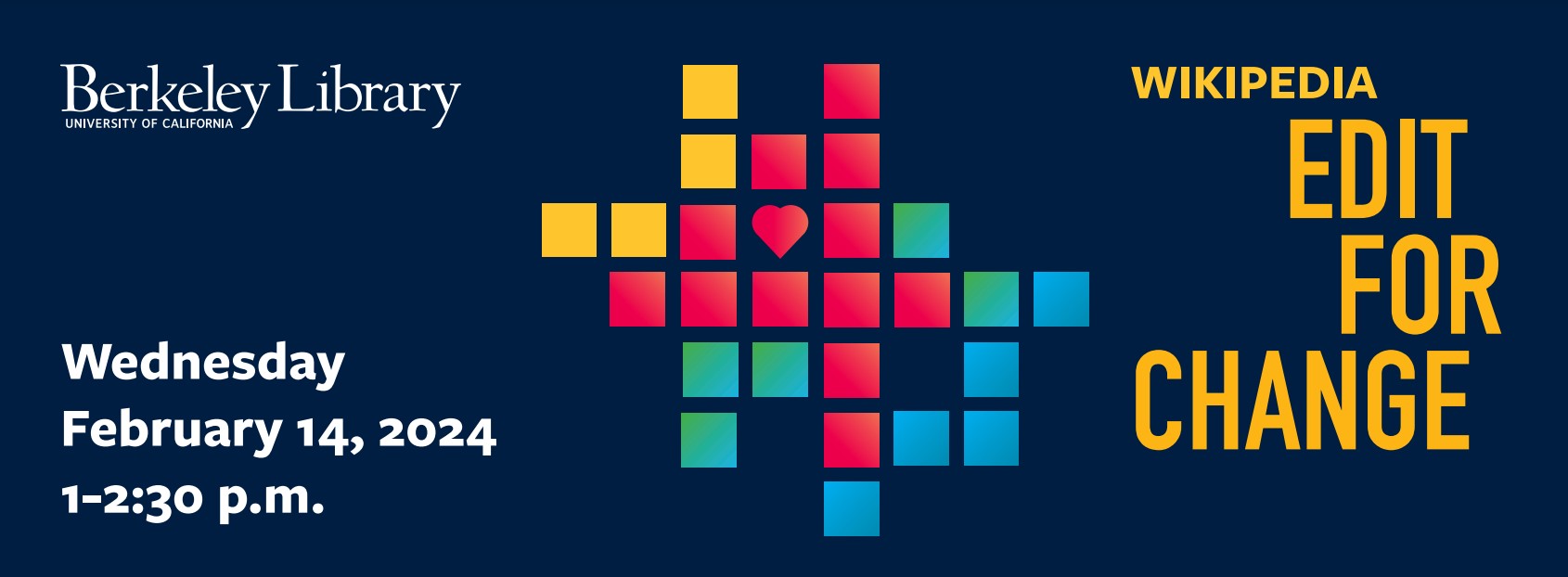
I am a proud Wikiphiliac. At least, according to the Urban Dictionary, which defines Wikiphilia as “a powerful obsession with Wikipedia”. I have many of the signs it warns of, including “accessing Wikipedia several times a day…spending much more time on Wikipedia than originally intended [and]… compulsively switching to other Wikipedia articles, using the hyperlinks within articles, often without obtaining the originally sought information and leaving a bizarre informational “trail” in his/her browsing history” (but that last part is just normal life as a librarian).
How else do I love Wikipedia? Let me count the ways! As a librarian, I always approach crowd-sourced information with a critical eye, but I also admire that Wikipedia has its own standards for fact-checking, and in fact some topics are locked to public editing. It takes its mission very seriously. It also has an accessible and neutral tone. Especially when I want to learn about a technical topic, it can give me a straightforward and helpful way to approach it. I also use it pretty routinely as a way to look at collections of sources about a topic; when I was a medical librarian, I was asked for data on the condition neurofibromatosis, and at that time the best basic links I found were in the references for the Wikipedia article. Last and maybe most importantly, the fact that anyone can edit is a huge strength…with challenges. Wikipedia openly admits its content is skewed by the gender and racial imbalance of its editors, and knowing this is part of approaching it critically, but it also means that IT CAN CHANGE, and WE CAN CHANGE IT.
Given that philia, a word taken from Ancient Greek (according to the philia Wikipedia article), means affection for or love of something, it’s fitting that our 2024 Wikipedia Editathon is part of UC’s Love Data Week, and happens on Valentine’s Day. If you would like to learn to contribute to this amazing resource, and perhaps even help diversify its editorial pool, we can get you started! There isn’t yet a Wikipedia page on Wikiphilia, but maybe you could create one! There already is a podcast series…
If you’re interested in learning more, we warmly welcome you and invite you to join us on Wednesday, February 14, from 1-2:30 for the 2024 UC Berkeley Libraries Wikipedia Editathon. No experience is required—we will teach you all you need to know about editing! (but, if you want to edit with us in real time, please create a Wikipedia account before the workshop—information on how to do that is on the registration page). The link to register is here, and you can contact any of the workshop leaders with questions. We hope you will join us, and we look forward to editing with you!
NOTE: the Wikipedia Editathon is just one of the programs that’s part of the University of California’s Love Data Week 2024! Don’t forget to check out all the other great UC Love Data Week offerings—this year UC Berkeley Librarians are hosting/co-hosting SIX different sessions! Here are those UCB-led workshop links, and the full calendar is linked here:
Thinking About and Finding Health Statistics & Data
GIS & Mapping: Where to Start
Cultivating Collaboration: Getting Started with Open Research
Code-free Data Analysis
Wikipedia Edit-a-thon
Getting Started with Qualitative Data Analysis
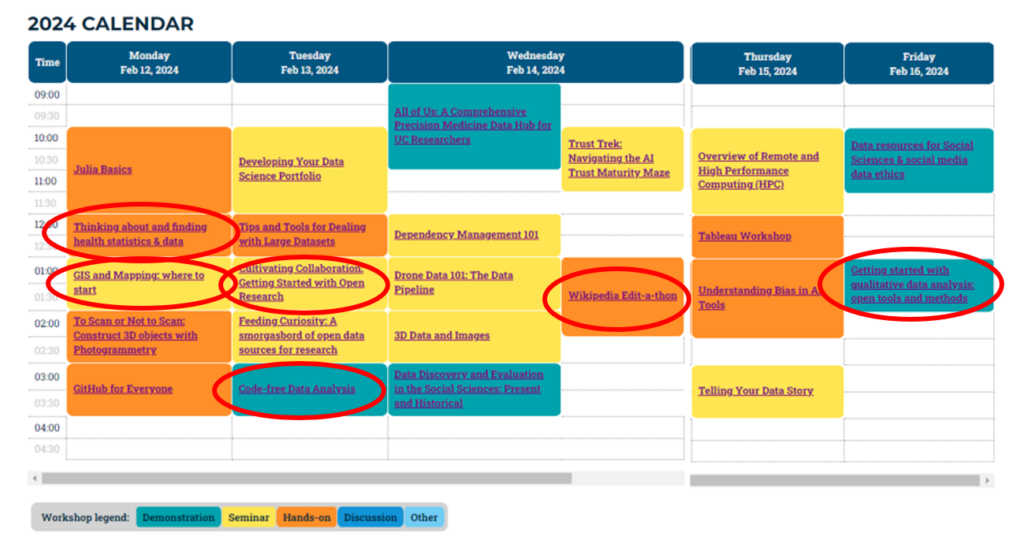
Come Help Us Create Wikipedia and Create Change, Edit by Edit, on February 15, 2023!

Wikipedia has become so central to our lives that we count on it to represent reality, and solid fact. When we encounter a new phenomenon, we check out our trusty online friend for more information. So, it was fascinating to me recently to see the lines blur between fiction and reality, when Wikipedia was used as a visual and social cue in the movie Tár, starring Cate Blanchett, about a famed female conductor. In the movie, one of the clues to the coming turbulence in Lydia Tár’s life is a screen capture of a mystery editor changing items on the conductor’s Wikipedia entry. It looked and felt so real, the filming and Blanchett’s performance so rivetingly vivid, that many people believed the film was a biopic of a real person. As Brooke LaMantia wrote in her article, No, Lydia Tar is Not Real,
“When I left the theater after watching Tár for two hours and 38 minutes, I immediately fumbled for my phone. I couldn’t wait to see actual footage of the story I had just seen and was so ready for my Wikipedia deep dive to sate me during my ride home. But when I frantically typed “Lydia Tar?” into Google as I waited for my train, I was greeted with a confusing and upsetting realization: Lydia Tár is not real…the film’s description on Letterboxd — “set in the international world of classical music, centers on Lydia Tár, widely considered one of the greatest living composer/conductors and first-ever female chief conductor of a major German orchestra” — is enough to make you believe Tár is based on a true story. The description was later added to a Wikipedia page dedicated to “Lydia Tár,” but ahead of the film’s October 28 wide release, that page has now been placed under a broader page for the movie as a whole. Was this some sort of marketing sleight of hand or just a mistake I stumbled upon? Am I the only one who noticed this? I couldn’t be, right? I thought other people had to be stuck in that same cycle of questioning: Wait, this has to be real. Or is it? She’s not a real person?
Wikipedia is central to LaMantia’s questioning! While it’s easy to understand people’s confusion in general, the Tár Wikipedia page, created by editors like you and like me, is very clear that this is a film, at least as of today’s access date, January 20, 2023… On the other hand, did you know you can click on the “View History” link on the page, and see every edit that has been made to it, since it was created, and who made that edit? If you look at the page resulting from one of the edits from October 27, 2022, you can see that it does look like Tár is a real person, and in fact, a person who later went on to edit this entry to make it clearer wrote, “Reading as it was, it is not clear if Lydia actually exists.” Maybe I should write to LaMantia and let her know.
I tell this story to show that clearly, Wikipedia is a phenomenon, and a globally central one, which makes it all the more amazing that it is created continuously, edit by edit, editor by editor. There are many ways in which our own and your own edits can create change, lead to social justice, correct misinformation and more. While it’s easy to get lost in the weeds of minute changes to esoteric entries, it’s also possible to improve pages on important figures in real-life history and bring them into our modern narrative and consciousness. And it’s easy to do!
If you are interested in learning more, and being part of this central resource, we warmly welcome you and invite you to join us on Wednesday, February 15, from 1-2:30 for our 2023 Wikipedia Editathon, part of the University of Calif0rnia-wide 2023 Love Data Week. No experience is required—we will teach you all you need to know about editing! (but, if you want to edit with us in real time, please create a Wikipedia account before the workshop). The link to register is here, and you can contact any of the workshop leaders (listed on the registration page) with questions. We look forward to editing with you!
Coming Soon: Love Your Data, from Editathons to Containers!
UC Berkeley has been loving its data for a long time, and has been part of the international movement which is Love Data Week (LDW) since at least 2016, even during the pandemic! This year is no exception—the UC Berkeley Libraries and our campus partners are offering some fantastic workshops (four of which are led by our very own librarians) as part of the University of California-wide observance.
Love Data Week 2023 is happening next month, February 13-17 (it’s always during the week of Valentine’s Day)!
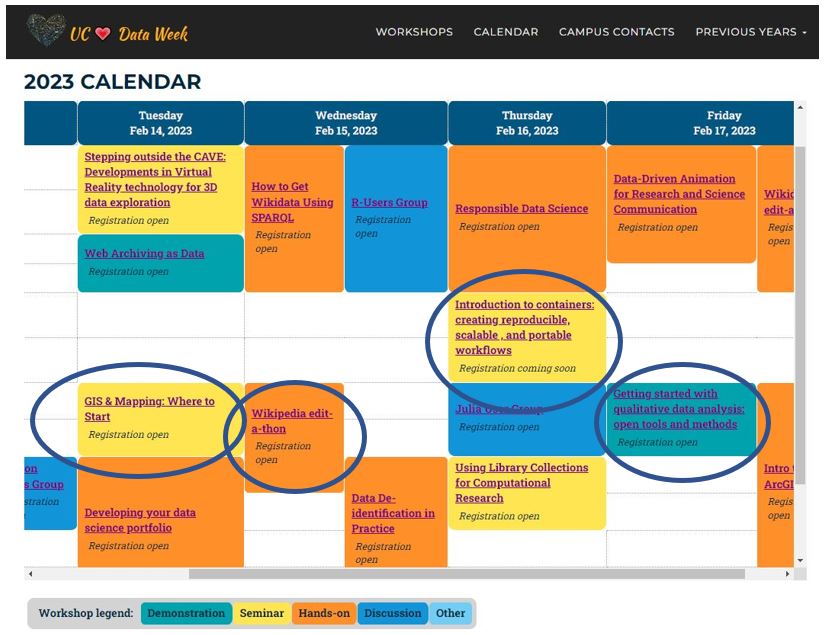
UC Berkeley Love Data Week offerings for 2023 include:
Wikipedia Edit-a-thon (you can also dip into Wikidata at other LDW events)
Textual Analysis with Archival Materials
Getting Started with Qualitative Data Analysis
All members of the UC community are welcome—we hope you will join us! Registration links for our offerings are above, and the full UC-wide calendar is here. If you are interested in learning more about what the library is doing with data, check out our new Data + Digital Scholarship Services page. And, feel free to email us at librarydataservices@berkeley.edu. Looking forward to data bonding next month!
Miracle on 47th Street
You may have searched the library’s new search interface, UC Library Search (now at one year post-launch!), and gotten a result for an item at NRLF, the Northern Regional Library Facility. It’s one of two cooperative storage facilities for the University of California, the other being SRLF, and when you consider that the University of California’s collection is the largest of research universities in the USA, you can understand why storage is a big deal. As a librarian, I’ve always sort of taken NRLF for granted, and certainly had never seen it—until this month, when I was lucky enough, with colleagues from the Social Sciences Division and the Interlibrary Loan department, to take a tour (spoiler alert—don’t miss the video at the end of this post!!!!).
This involved a trek to the Richmond Field Station, where the NRLF sits at the intersection of Meade and S. 47th Streets, just under 8 miles NW of Doe Library on the main campus. While unassuming from the outside, the NRLF complex, which manages physical access to and metadata for items deposited primarily by libraries at the UC’s northern campuses (UC Berkeley, UC Davis, UC Merced, UC San Francisco and UC Santa Cruz), currently holds more than 7.5 million items. The logistical challenges and scale are momentous, and the fact that it is all beautifully organized and our tour hosts were calm and welcoming is miraculous to me (hence the title of this post). Take for example the banner below—3 million items are all in a day’s work for the staff at the NRLF!! (I exaggerate, but not much).

The complex has been constructed in phases, with storage areas corresponding to each. Below is a picture of the Phase 1 area—when I walked into it, I got a hit of the vastness of space that you get in that very last scene of Raiders of the Lost Ark, where the ark is being wheeled into the massive storage area in some government building somewhere (see the picture here– apparently I’m not the only one with this image burned into my brain). In the NRLF’s case, the shelves are all filled with books and other library items, with the difference from the random packing of the movie image being that they are barcoded by location for retrieval, to avoid loss and mis-shelving (as with any large library, if you misplace an item, it may stay lost for a long time). In the NRLF’s Phase 1 picture below, you are seeing just the lowest of four levels going up to the roof. Also note that the spaces are climate controlled, so as better to preserve the items. Any items sent for storage which are not in good condition may be regretfully rejected, since conditions like mold in a book can be detrimental to items nearby. Also notice here the rolling library stairs on steroids that are used to retrieve items from higher shelves (I’ll come back to these below).
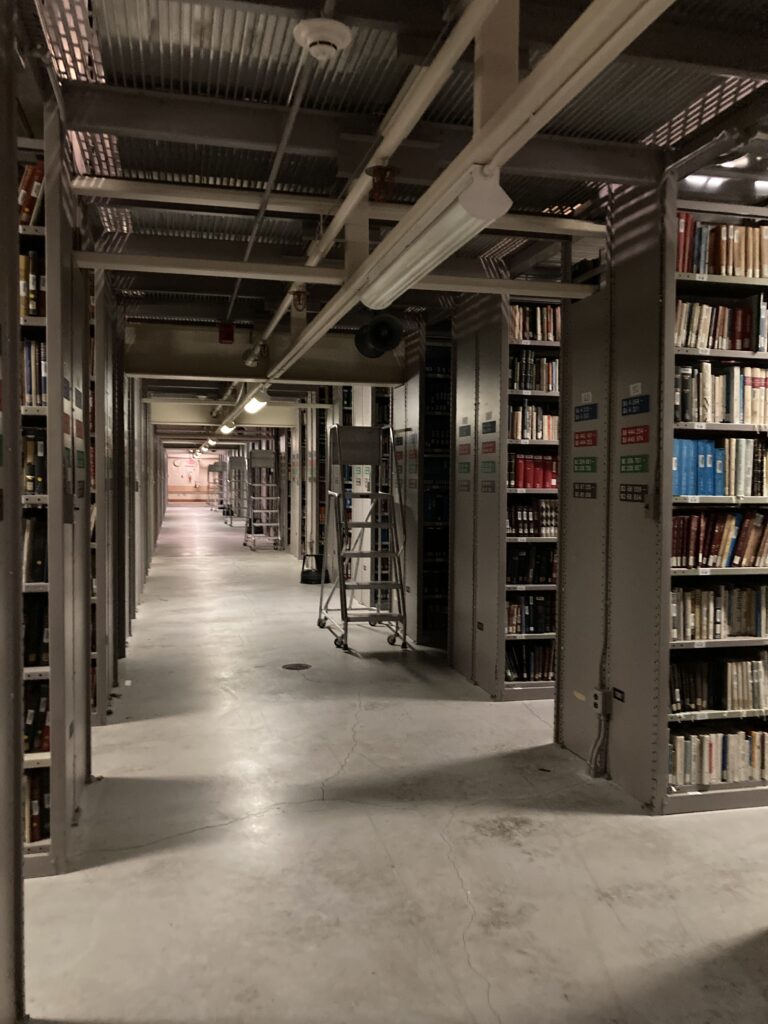
Once I’d gotten my head around the sheer vastness of the spaces and the amazing logistical innovations for managing the spaces and the items (visualize iPads with specialized software, taking into account Wifi availability, staff availability and training, and more), my next impression was just – carts, carts, CARTS! So many carts! Each had a planned purpose and location, highlighting the amount of care and work it takes just to process items being accepted for storage—you aren’t just throwing them onto shelves as you might in your own attic. And, in the picture immediately below, you can see that the items aren’t coming in neatly organized by subject, nor are they eventually shelved that way. Thanks to barcoding technology and software for using it, it’s the location of the item that matters for retrieval, so it’s fine to shelve the book Cancer Detection and Prevention two books away from Glassmaking in Renaissance Venice, as long as you can find each when requested by a library user. This is the difference between browsing a collection organized by subject, and trying to store and retrieve so many disparate items coming at you in random order.
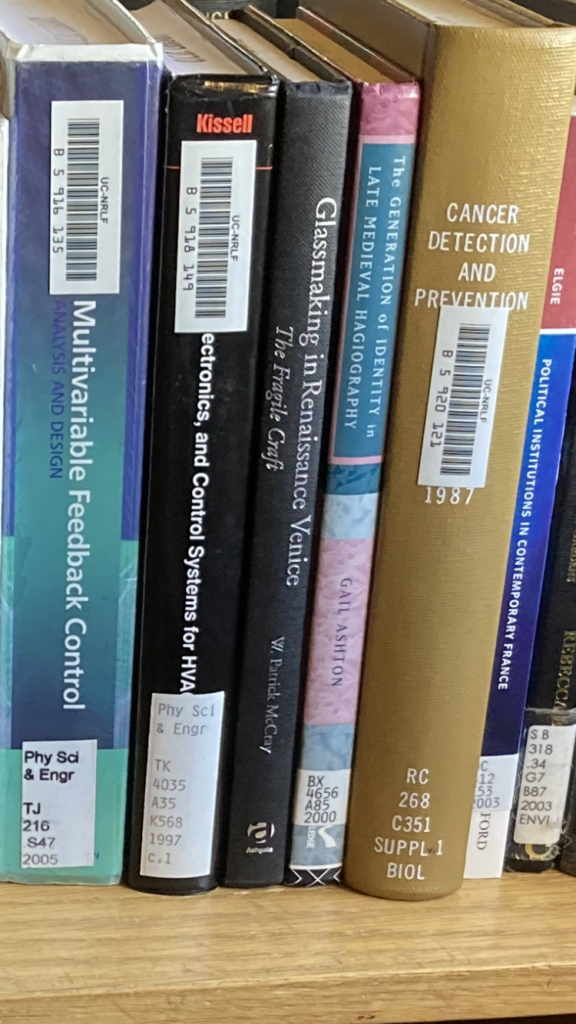
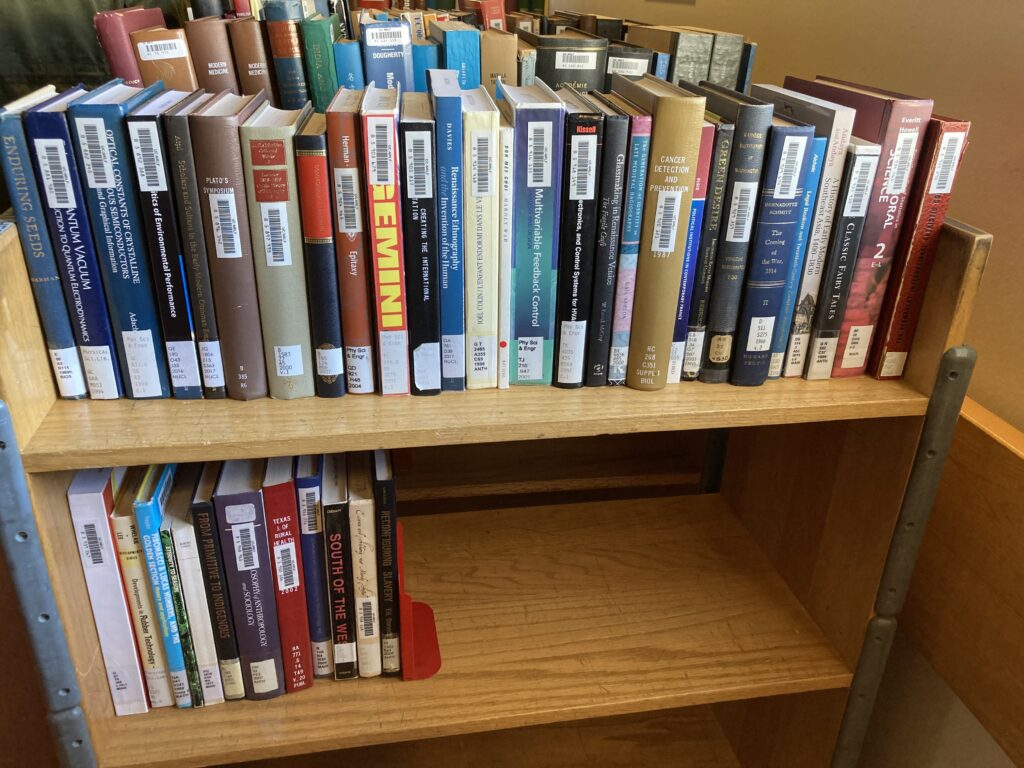
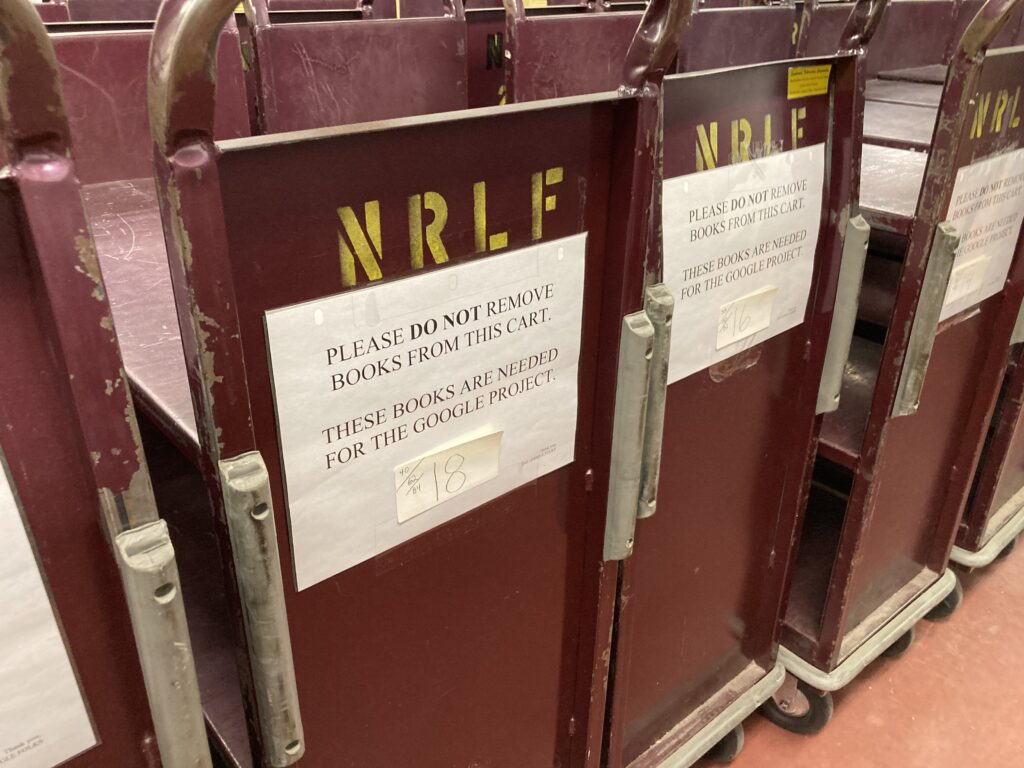
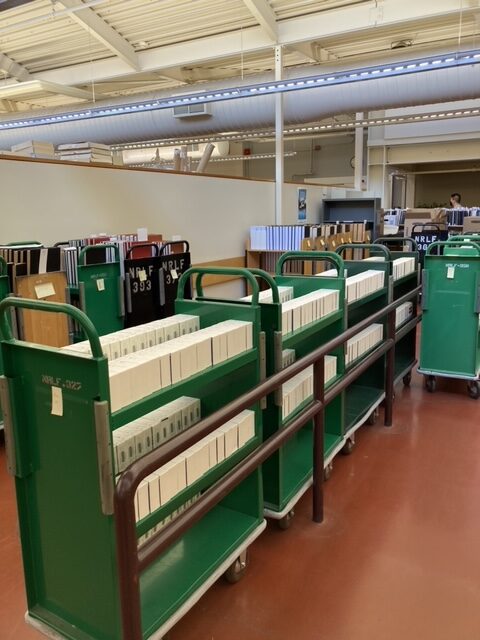
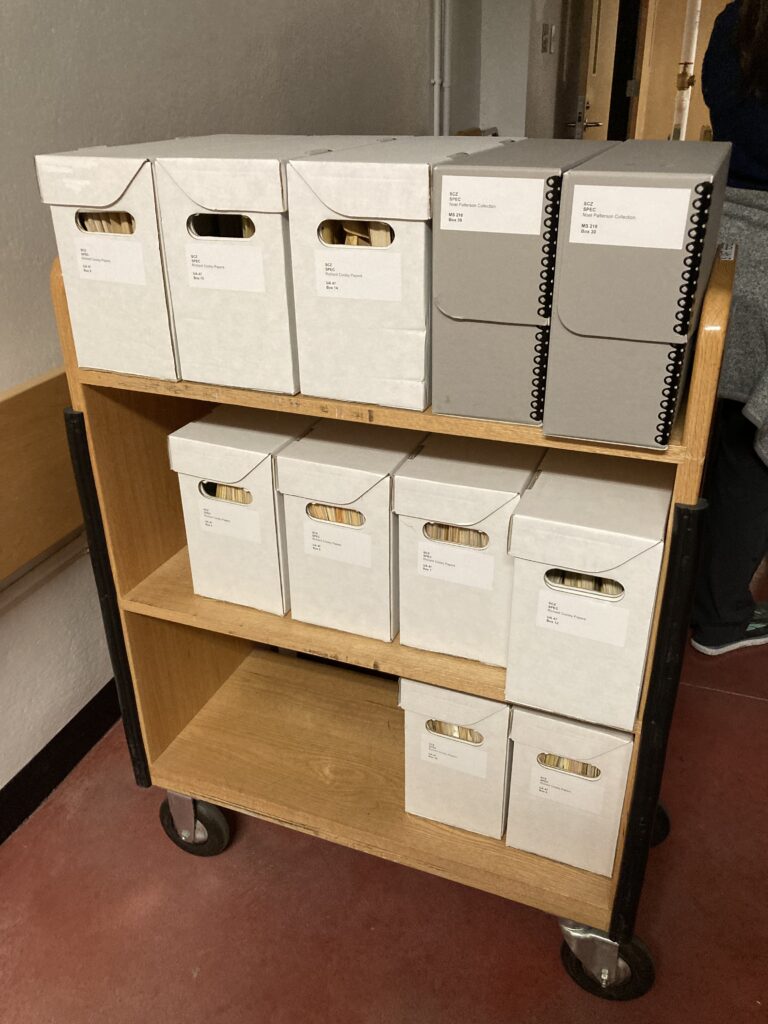
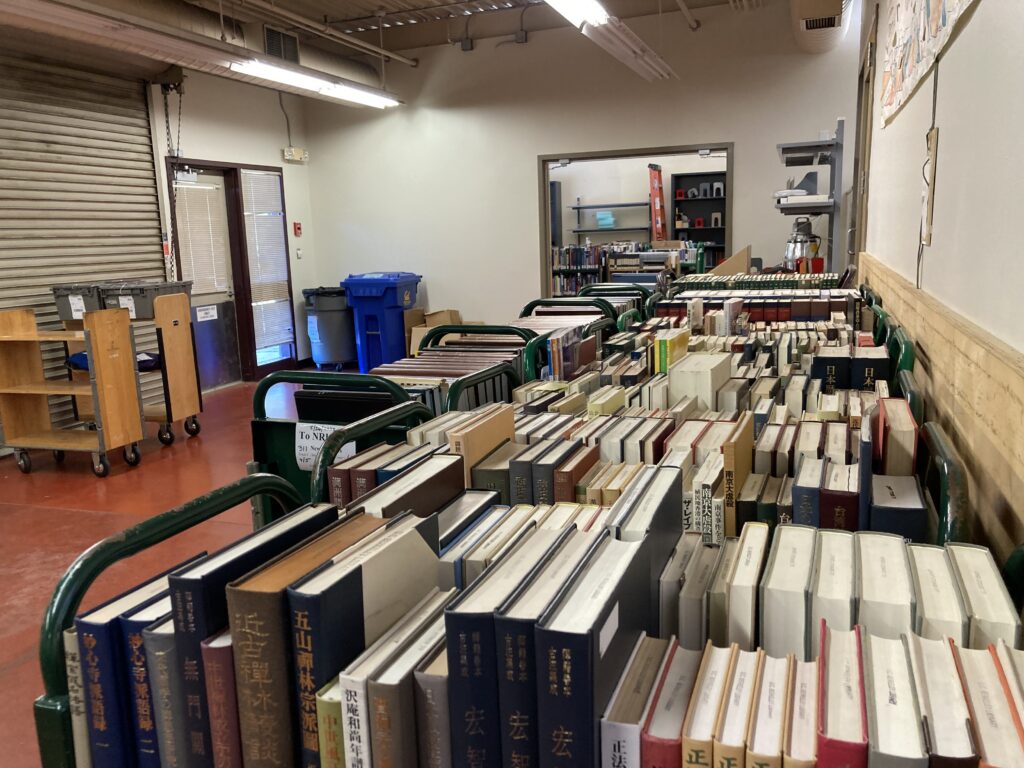
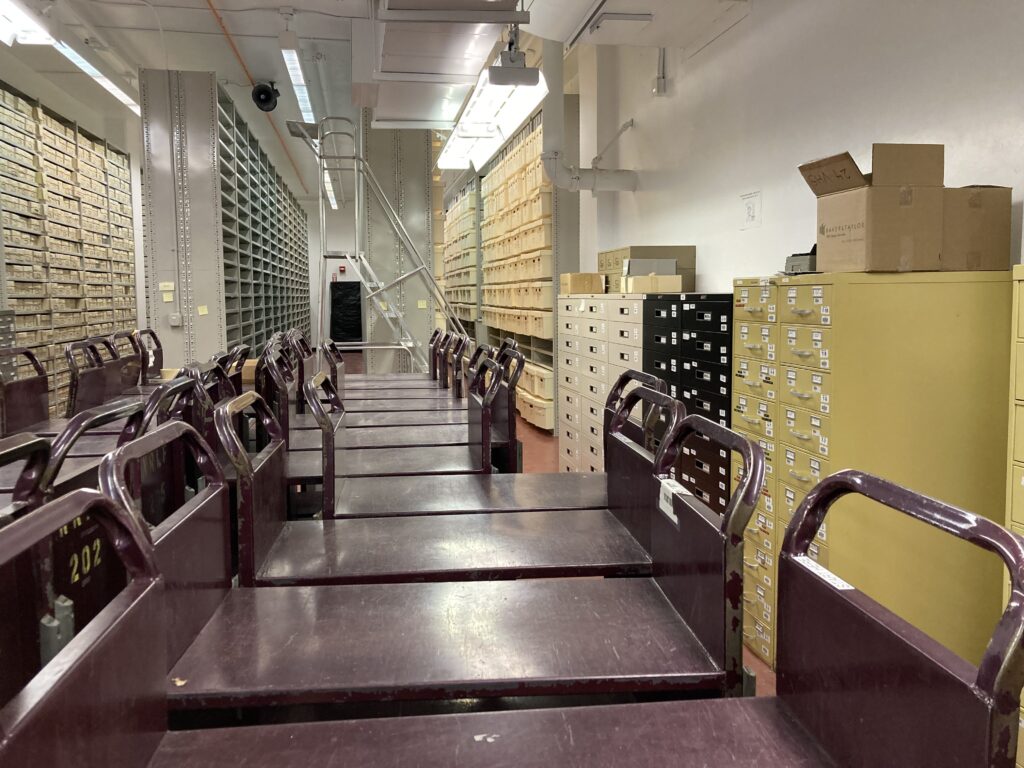
In the picture immediately above, in addition to having carts (natch), notice the varying types of cabinets. This is because while we mostly think about storing books, NRLF actually holds a wide range of item types, including, besides books and journals. “microfilm, maps, audio discs, manuscripts, archives, and other materials”. Here we see the Microforms Room, which holds stored ranges of microfiche and microfilms (at UC Berkeley, a great place to see what these formats look like up close and personal will be when the Newspapers and Microforms Library reopens after its construction-related closure).
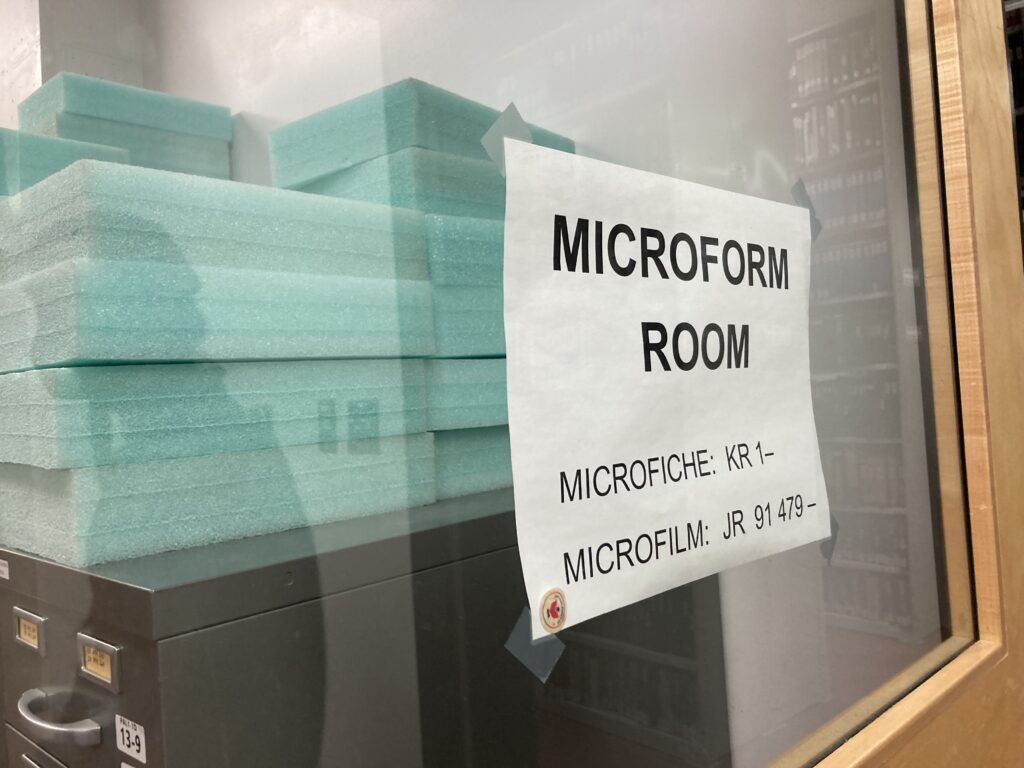
The final stop of the tour was to the Phase 4 building, which will be able to hold 2.5 million items itself, and is in the early stages of being populated with items. It should be able to accommodate storage for the UC system for the next several years, but no worries since the location of the Phase 5 storage area is right nearby for when it’s needed! The pictures below show the large open working space (for now—but surely it will fill up too), and also a diagram for measuring item size so that the space used by the container boxes for the items is maximized (again, this is why it’s great to be able to shelve by location and not subject—you can put all the similar sized items together in a box without worrying that a similarly-themed title is twice the size of the largest book already in that box).
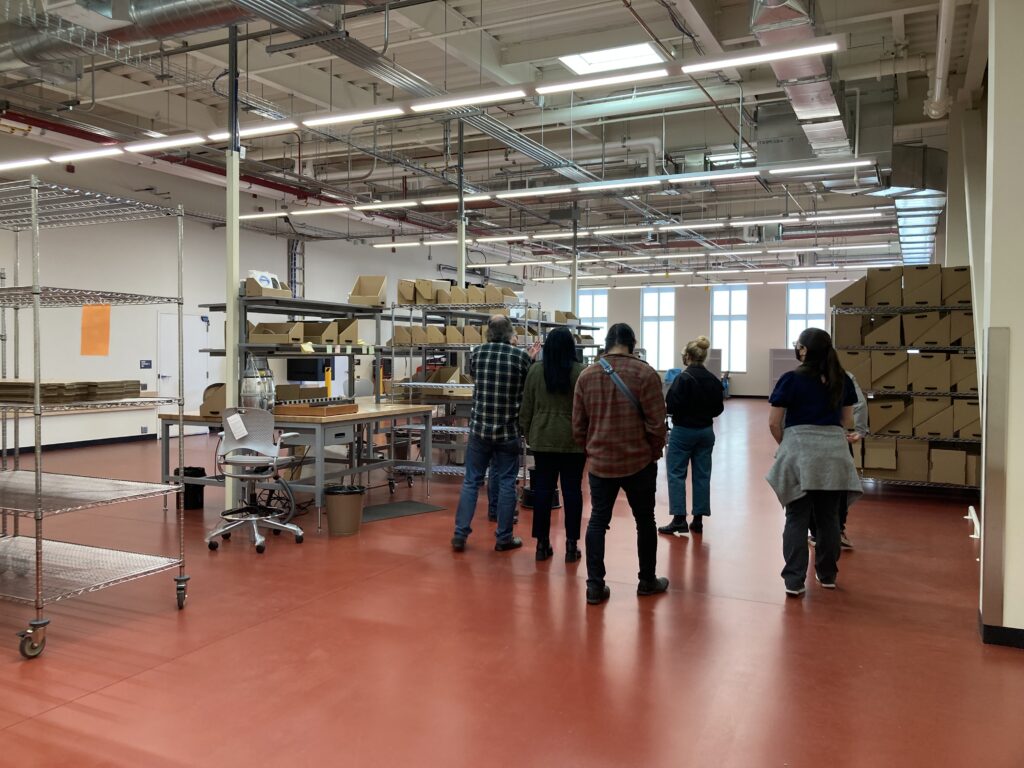
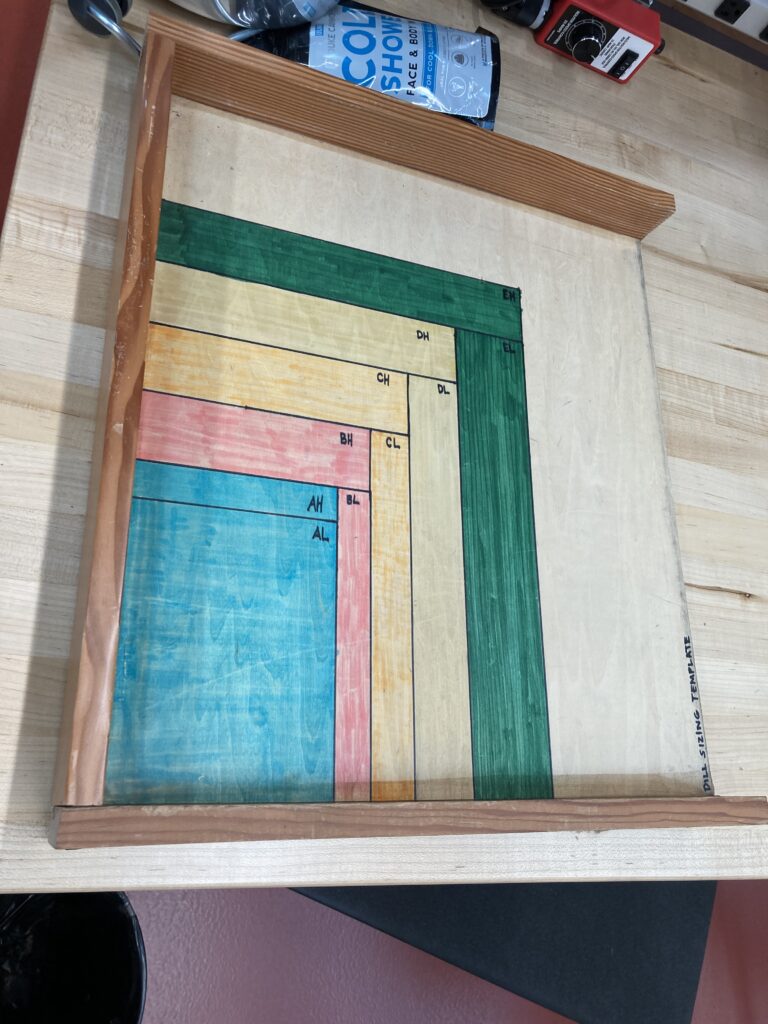
The absolutely most cool part of the tour by far was seeing the machinery that is used for retrieval of items. Remember the picture above from Phase 1, with the library stairs on steroids? This new machinery is not your grandmother’s library stairs—it is next level high tech! In fact, it needs training and certification to be able to use it at all. In the picture below you can see the Phase 4 shelving, and the machine that navigates it for retrieval of items. The machine even has forks at the bottom (similar to those on a forklift) that can carry an entire cart along with it, using the specially made carts with insert points (circled), shown in the second picture below.
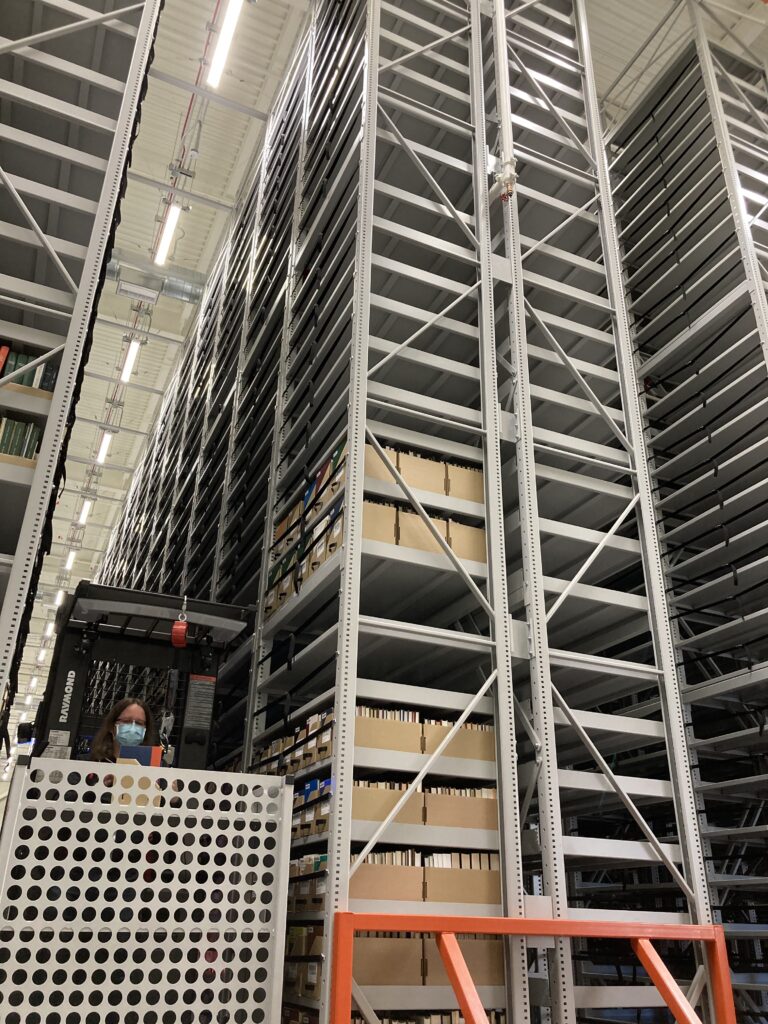
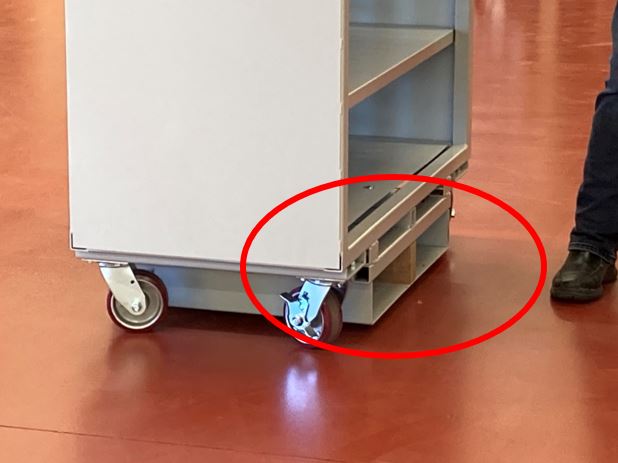
But, actually, this process needs to be seen to be believed! So, here, for your viewing enjoyment, is the video mentioned at the beginning of this post!
As a parting note, the below picture is of an internal exit point from the building. Everyone on the tour (remember that library folks do tend to have some—or a lot—of geek in them) enjoyed the fact that the black stripes on the side of the Phase 4 building represent bar codes used for actual titles in the collection! Our wonderful hosts sent us a list of the titles after the tour, writing:
“Below are the titles whose ISBN barcodes were selected by the SLFB as metal siding patterns for NRLF Phase 4:
- Fiat Lux: The University of California, 1967, ISBN–10: 1125257695 ISBN–13: 978–1125257692
- The art of the book / Charles Holme 1990 edition of a 1914 printing ISBN: 088029504X or 9780880295048 (https://archive.org/details/artofbook00holm)
- It’s a book / Lane Smith ISBN:9781596436060 or 1596436069
- A Brief History of the University of California, University of California Press, 2004. ISBN 9780520938533 0520938534
- The Mountains of California, Modern Library Classics Ed. by John Muir, 978–0375758195
- The Ohlone Way: Indian Life in the San Francisco-Monterey Bay Area by Malcolm Margolin, Heyday Books, Berkeley, CA 1978 ISBN-13: 978-0930588014”
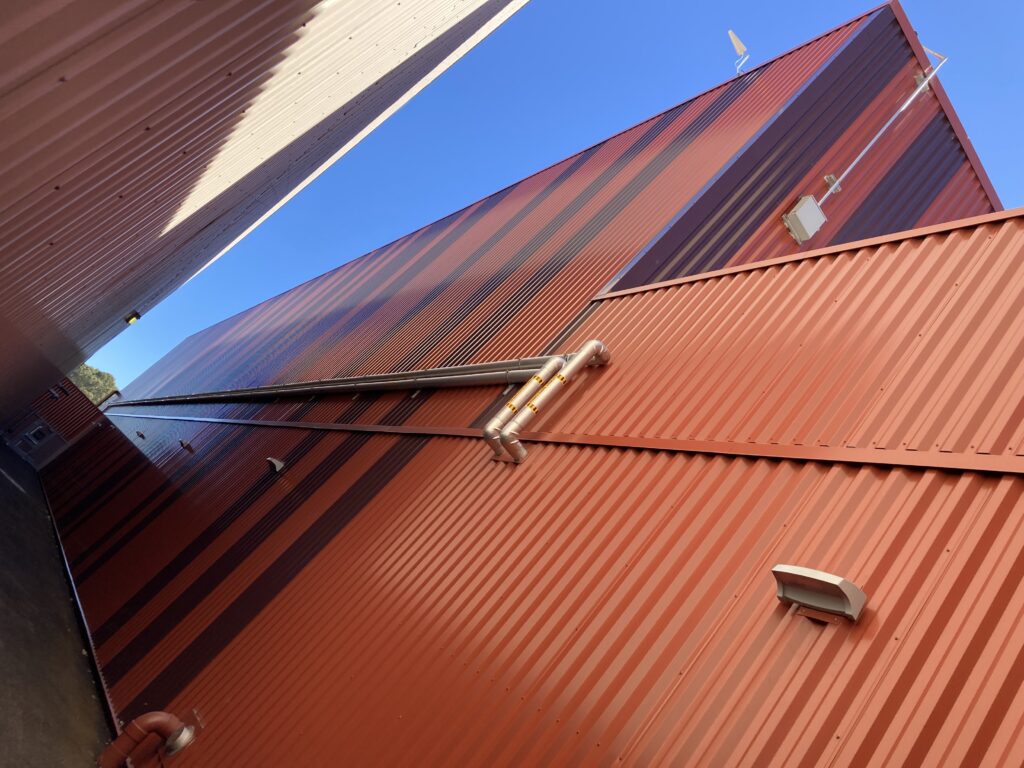
If you’d like to visit the NRLF, there is a reading room open to the public. The stacks are not physically browsable due to how they’re organized, but users can find all items stored at NRLF by virtually browsing UC Library Search. With enough advance notice, materials you need will be prepared and available to use when you arrive. And you will receive a warm welcome, as our tour group did!
The Pot of Gold!
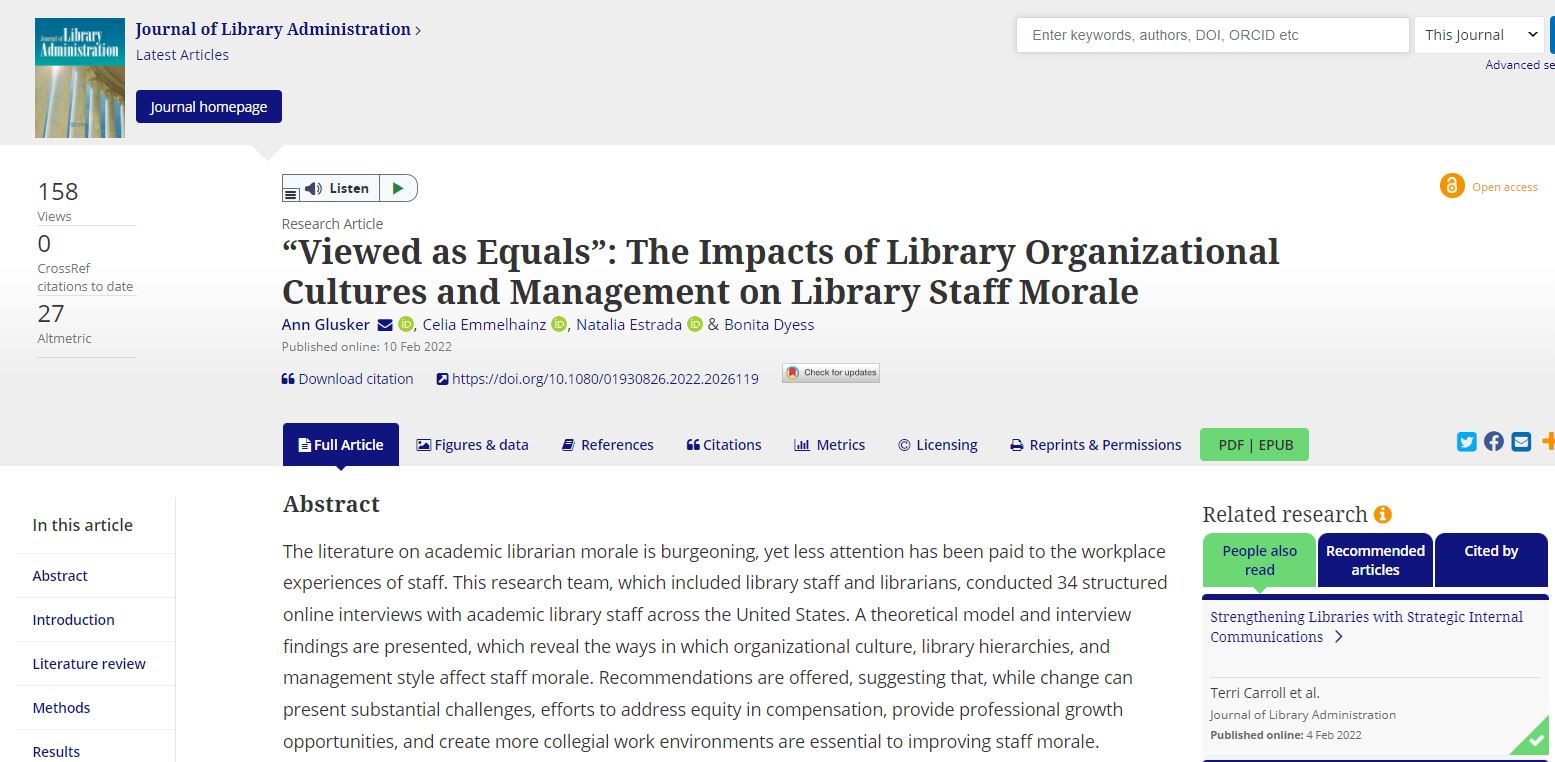
You may have seen an earlier post in this blog about a library research journey, related to a study on the morale of library staff. There is a growing body of work exploring the morale of librarians, but not much on that of library staff, and like any good researchers, our research team (librarians, staff, and former library staff) pounced on the gap in the literature! That earlier post outlines how the project got started, its early phases, and getting to the point of presenting our initial findings. As well as the fact that the interviews and in fact the entire process pretty much happened during a pandemic.
But, when that was written, we hadn’t done any detailed data analysis yet, and we were still a ways away from the ultimate goal of publishing the study, in order to make it widely useful. Well, nine months later (amazingly quickly) that day has arrived—goal met, destination arrived at, pot of gold at the end of the rainbow, in hand! The paper has been published! Here’s what happened between then and now.
First, we actually got invited to submit the paper, by the editor of the Journal of Library Administration. That was pretty exciting in itself, and surely is largely due to the above-mentioned lack of research on this topic. Next, came the actual analysis of the transcripts of the interviews, conducted with library staff nationwide, using the qualitative data software MAXQDA. Using a tool such as this helps ensure that there is rigor in extracting the themes from the content, and I can testify that this process brings up themes and patterns you might not otherwise expect or extract! Then, because of the choice to use a research method called grounded theory, it was important to develop a theoretical model of what had evolved (this happens after extracting the themes). That brought up even more relationships and connections to consider!
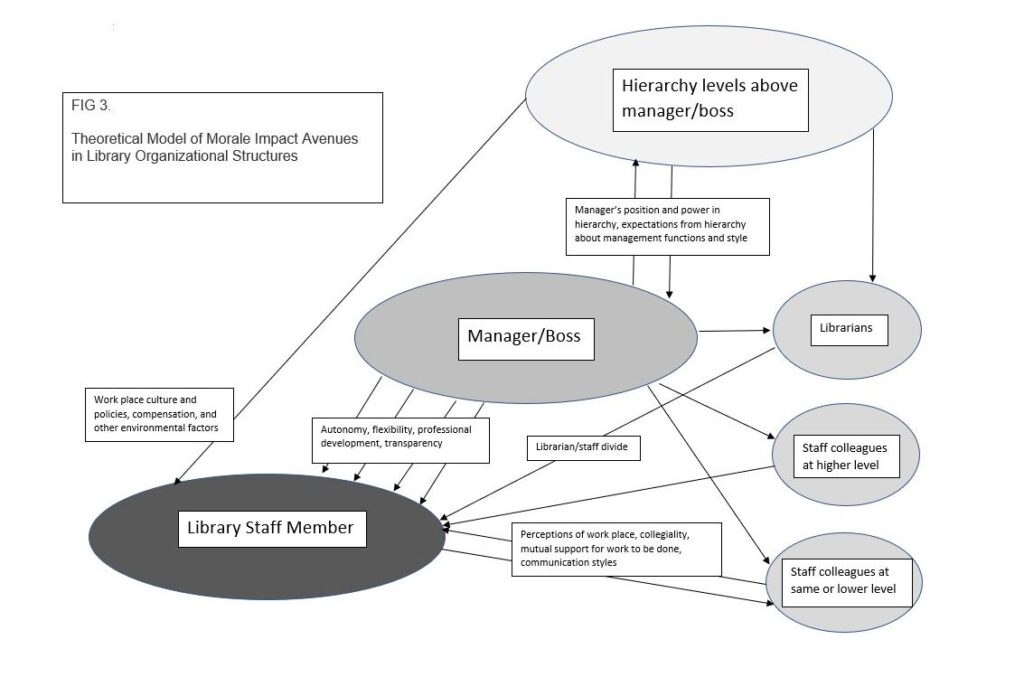
At this point—time to write. Not in order—it was easiest to warm up with the introduction and methods sections, and actually the discussion and conclusion sections came next, since we’d already presented on the material and had a sense of what those would look like. After that came the literature review. Yikes, we had a Zotero library of more than 90 articles, of which 62 made it into the paper as references. That was a lot of synthesizing! But it also meant we could confidently say that we believe this is the very first in-depth qualitative study of the morale of library staff, which makes us feel that our work may be able to help libraries create positive changes for staff in library settings. By the way, using the citation management software Zotero, that reference list of 62 was populated in Word instantaneously, a far cry from the hours I spent typing the references for my dissertation on a typewriter!
Finally came the results section, the core of what we had found out, which notably includes many quotes representing the lived experiences of our 34 wonderful respondents. And, while this is not commonly done, it made sense to include not just ideas for directions for future research, but also some of the broader questions needing to be answered, that came from the wisdom of attendees at our presentations. There are also appendices with everything anyone would need to recreate our study. Which we very much hope someone will do, in the new post-COVID normal.
Next—the maze of submission to the journal: forms, making sure that author guidelines were strictly adhered to, and similar. And the waiting! It takes time to send a paper to be peer reviewed, to get and address the comments and resubmit, and get a final acceptance. But that all happened, and along with it, the chance to exhale after two years of work.
An important final detail involved whether or not the paper could be published open access, that is, freely available to ANYONE who clicks on it, whether or not their library carries the journal title. Publishing open access would be one way to honor our amazing 34 respondents, meaning that library staff who need to see and think about these issues can download immediately. But, the out of pocket cost to us from the journal (called an article processing charge, or APC) would be $3085. Impossible. Given that price, it would have to be OK to just deposit the pre-print in the UC’s eScholarship portal, and it could be found that way. But then we learned that UC Berkeley authors, through an agreement between the California Digital Library and the publisher, could get a 75% discount on the APC—almost exactly what we had left in our research funding from LAUC! So, now on the upper right of the article’s landing page you can see that beautiful, beautiful open access logo. If you are reading this, you can read the article too!

We hope you’ll take a look, and send comments and questions our way, to librarystaffmorale@berkeley.edu. Thanks for reading this, and celebrating with us!
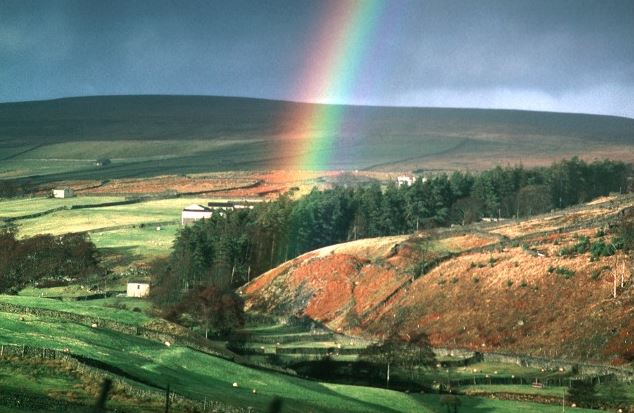
Create Change With Us: By Editing Wikipedia!
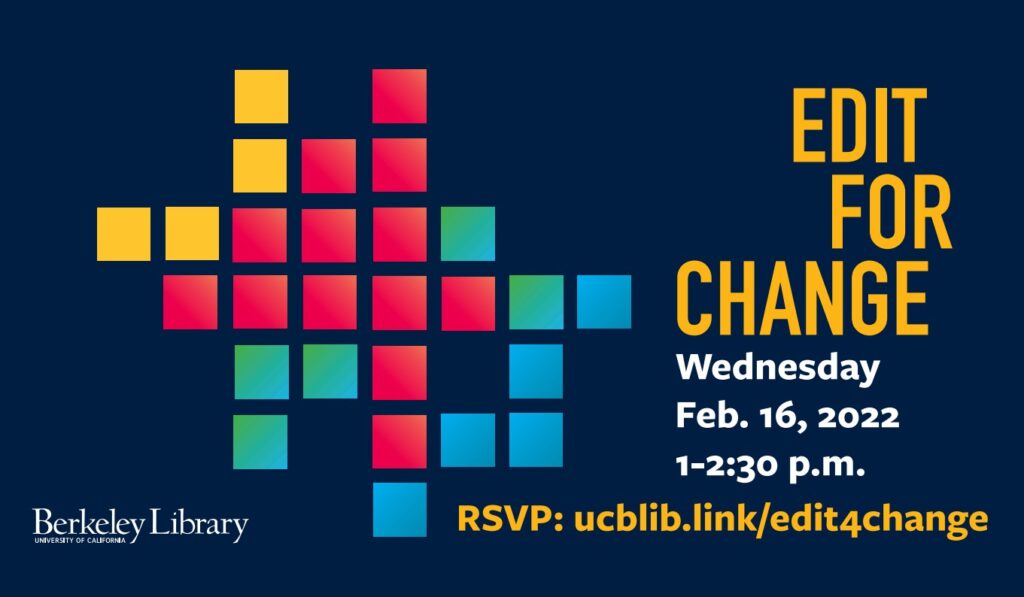
EVENT: Wikipedia Edit for Change: Workshop + group editing
Wednesday, February 16, 1:00pm-2:30pm
We look forward every year to offering the annual Library Wikipedia Editathon, but this year we’re mixing it up in some exciting new ways!
First, what is an editathon? It’s familiar to many of us to think about Wikipedia as a crowd-sourced online encyclopedia, which means that it’s only as good as its individual entries. Library communities in particular are deeply committed to the quality of information in this much-used resource. So, supporting Berkeley in learning to edit through a group editing event, with workshops for beginners, that is, an editathon, is a natural fit for us at the Library.
Second, what are we doing to mix it up? Our focus is Edit For Change—we will support you in editing Wikipedia towards any change you’d like to see! There is always room for improvement in Wikipedia’s topics and content. We’ll offer an introductory level Wikipedia workshop to support you in editing Wikipedia even if you’ve never edited before, and following the workshop, we’ll make edits together so you can pursue your editing interests more fully.
As an added bonus, we’re also excited to pair with the new initiatives of the recently-launched Library Data Services Program. This year we’re part of the University of California’s Love Data Week event calendar, which is an invigorating connection. How does Wikipedia connect to data? You may have heard of Wikidata, but there are also other connections between Wikipedia and data science: for example, Wikipedia’s content is a treasure trove for researchers who analyze textual content using data science methods. Here are some examples of the kind of research that is happening now, and here and here are some suggestions for approaching these methods if you are interested!
Intrigued? We’d love to have you come participate in the event! Registration is at ucblib.link/edit4change . Questions? Feel free to email us at editathon@lists.berkeley.edu, and we hope to “see” you on February 16!
A LAUC-B Conference to Remember!

LAUC-B is the Berkeley chapter of the Librarians Association of the University of California, and it helps us librarians in so many ways. When we come to campus to interview, we have lunch with LAUC-B representatives (and the conversation is confidential, so we can ask the REAL questions we have). When we arrive as new librarians, LAUC-B connects us with mentors. It provides support for our promotion and review process, and it provides a strong sense of community as we navigate this complicated campus.
One important thing LAUC-B does is offer professional development sessions, culminating in its conference every two years. The 2021 conference (which we posted about here the other day) just concluded, and multiple attendees, from all over the country (and even internationally) said that it was the best one they’ve attended in the past year (just to pat ourselves on the back a little bit!). So, what does a great librarian conference look like?
First of all, it takes a village; this year, for the first time, we Berkeley librarians welcomed librarians from other UC campuses to help us, and we had planning committee members from UCLA, UC Irvine, and UC San Diego. Second, it takes communication; in the online world created by the pandemic, at the same time we both needed to get the word out widely, and we were able to, by using email lists, social media, and other channels. This was so important, because the conference content—which was amazing—depended on us reaching a range of people and settings and locations. Third, it takes flexibility (with a large dose of preparation)! The planning committee was taking the conference from its historical in-person format to happening online for the first time, and that came with many challenges, even given the wonderful support from the Library Events Department—we changed conference platforms at the last minute, we became experts at Zoom bombing prevention, and learned more than we thought possible about captioning so that we could be ADA compliant.
The title of the conference is “Reimagining Libraries Through Critical Library Practices”, and our description notes that: “Library work is embedded in and inherently tied to socio-political circumstances. The programming in this conference examines librarianship through the lenses of social justice, diversity, equity, inclusion and anti-racist work, Black studies, Latinx studies, Indigenous studies, cultural and critical ethnic studies, intersectional feminism, critical disability studies, postcolonial and decolonial studies, and queer interventions in digital studies.”
We felt extremely fortunate that the proposals we received were so on point and so strong and deep, including: invited keynote presentations from Clara Chu and Lalitha Nataraj; 6 additional featured presentations; 5 lightning talks; and 11 posters (with which attendees had two different time slots to engage). Many of the presenters included a land acknowledgement and/or a positionality statement as they began their talks, engaging the attendees to consider their own locations and positions, and the UC Berkeley statement included this Rematriation Resource Guide from the Sogorea Te’ Land Trust. Attendees also agreed to uphold the conference’s Code of Conduct Statement.
If you’d like a sense of the 2-day event, please take a look at the conference website, and also at our Twitter hashtag. Session recordings will soon be available, linked on the website and hosted on the Library’s YouTube channel. Also notable were the elegant design offerings, including the logo you see above, which were created by UC Berkeley Library staffer and graphic designer Sarah Chieko Bonnickson, as well as the atmospheric and stress-reducing playlist, which was relayed between sessions and about which people raved, by UC Berkeley librarian Kristina Bush. If you have questions or comments, feel free to contact us at laucbconfinfo [at] lists.berkeley.edu, and please enjoy the Twitter screenshots below, while we enjoy our (distanced) celebratory beverages!
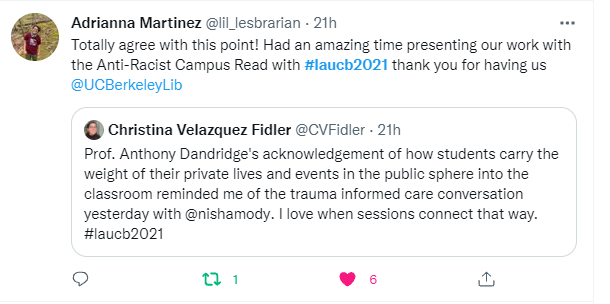
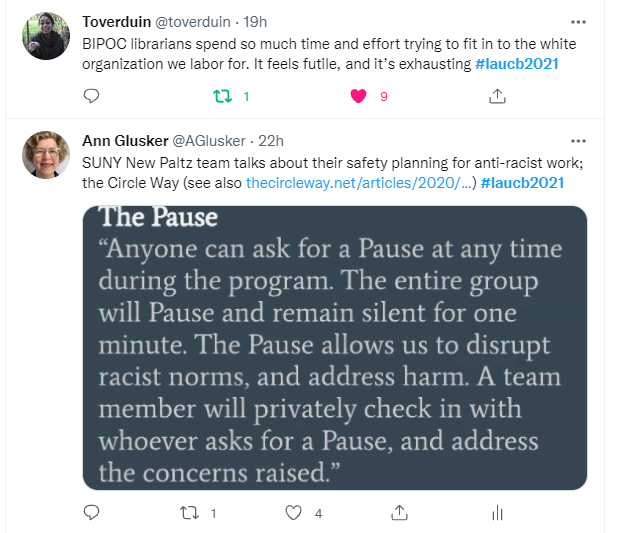
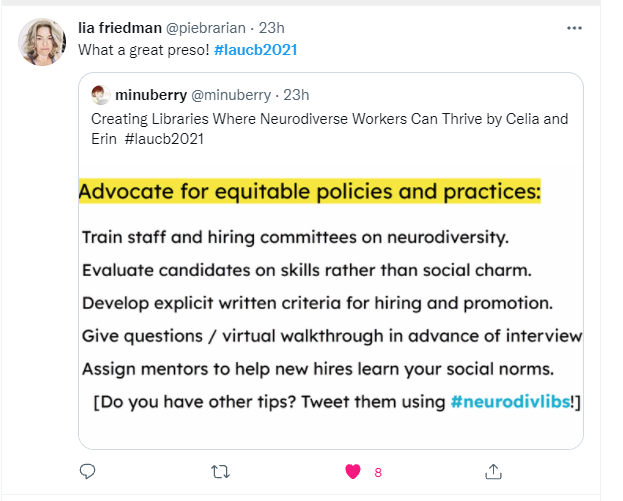
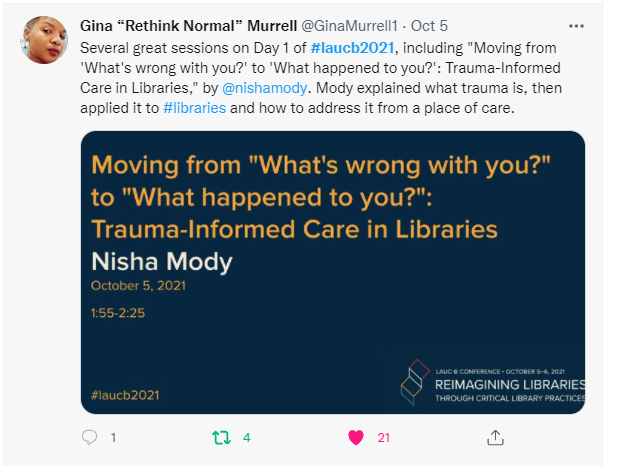
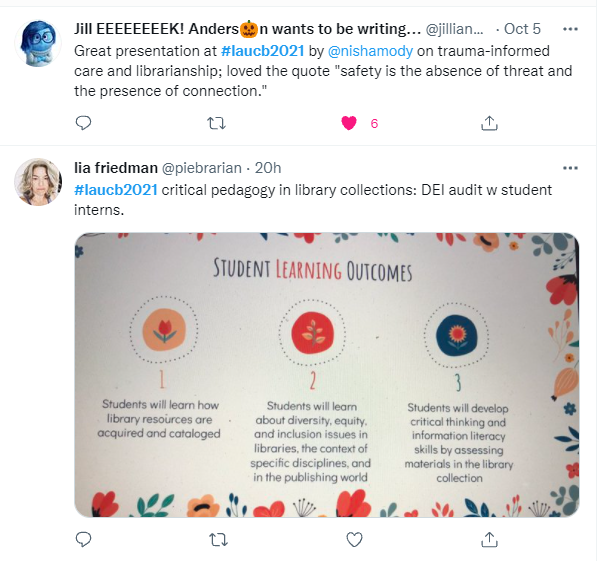
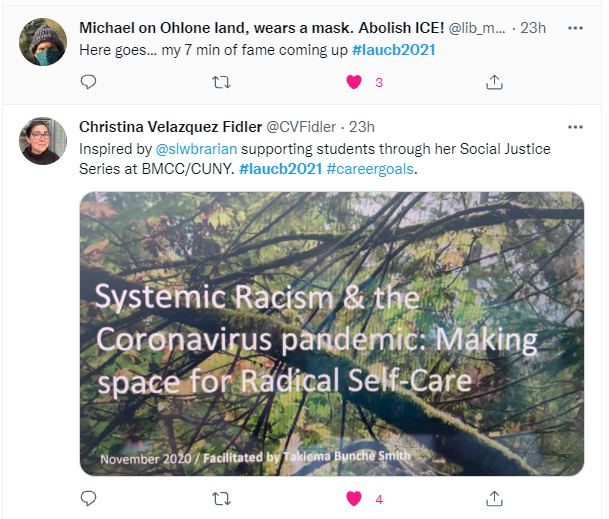
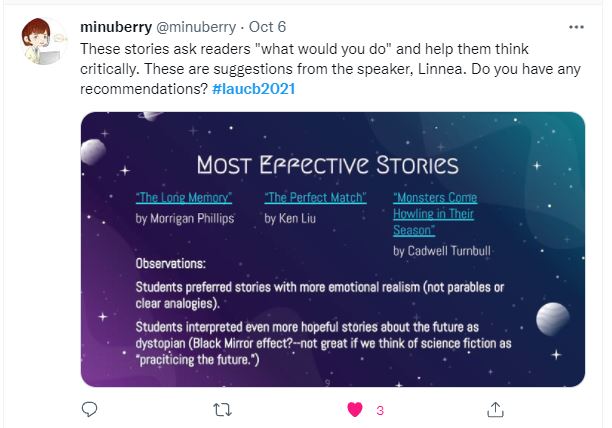
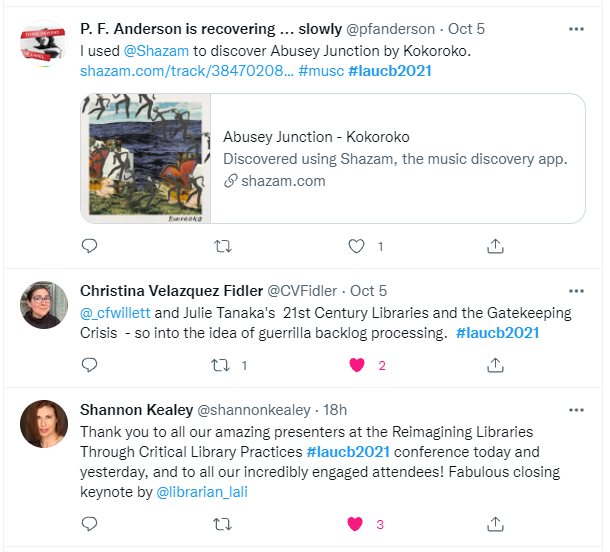
“Big Data as a Way of Life”: How the UCB Library Can Support Big Data Research at Berkeley
This post summarizes findings and recommendations from the Library’s Ithaka S+R Local Report, “Supporting Big Data Research at the University of California, Berkeley” released on October 1, 2021. The research was conducted and the report written by Erin D. Foster, Research Data Management Program Service Lead, Research IT & University of California, Berkeley (UCB) Library, Ann Glusker, Sociology, Demography, Public Policy, & Quantitative Research Librarian, UCB Library, and Brian Quigley, Head of the Engineering & Physical Sciences Division, UCB Library.
OVERVIEW:
In 2020, the Ithaka S+R project “Supporting Big Data Research” brought together twenty-one U.S. institutions to conduct a suite of parallel studies aimed at understanding researcher practices and needs related to data science methodologies and big data research. A team from the UCB Library conducted and analyzed interviews with a group of researchers at UC Berkeley. The timeline appears below. The UC Berkeley team’s report outlines the findings from the interviews with UC Berkeley researchers and makes recommendations for potential campus and library opportunities to support big data research. In addition to the UCB local report, Ithaka S+R will be releasing a capstone report later this year that will synthesize findings from all of the parallel studies to provide an overall perspective on evolving big data research practices and challenges to inform emerging services and support across the country.

PROCESS:
After successfully completing human subjects review, and using an interview protocol and training provided by Ithaka S+R, the team members recruited and interviewed 16 researchers from across ranks and disciplines whose research involved big data, defined as data having at least two of the following: volume, variety, and velocity.
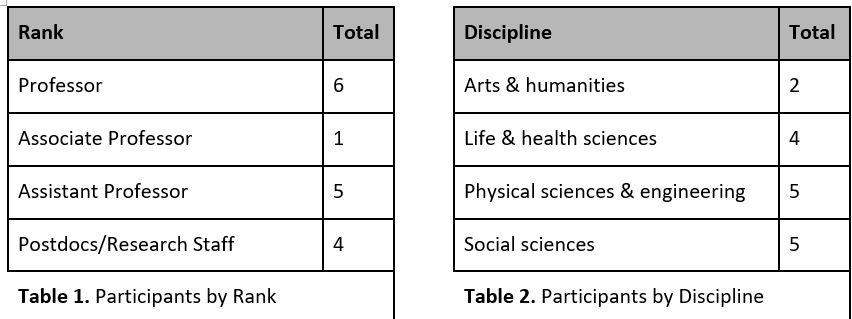
THEMES:
After transcribing the interviews and coding them using an open coding process, six themes emerged. These themes and sub-themes are listed below and treated fully in the final report. The report includes a number of quotes so that readers can “hear” the voices of Berkeley’s big data researchers most directly. In addition, the report outlines the challenges reported by researchers within each theme.
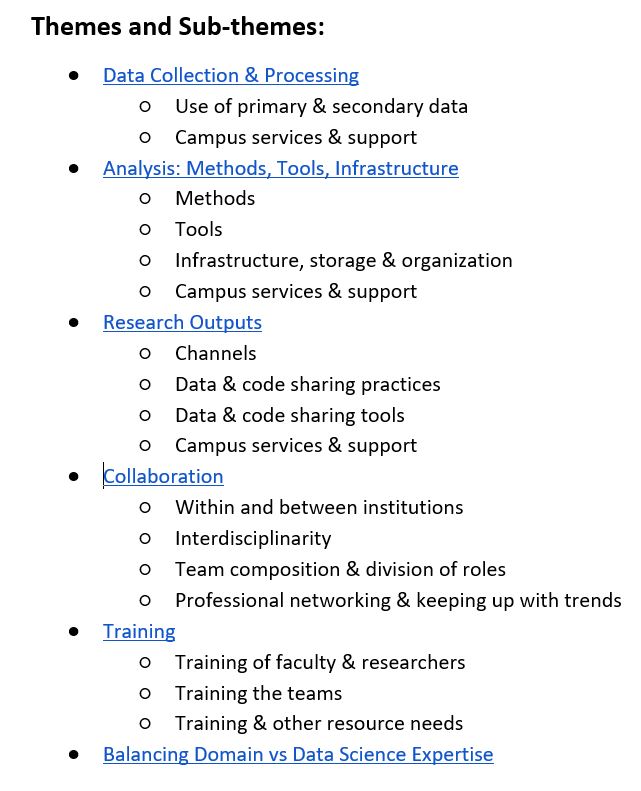
RECOMMENDATIONS:
The most important part of the entire research process was developing a list of recommendations for the UC Berkeley Library and its campus partners. Based on the needs and challenges expressed by researchers, and influenced by our own sense of the campus data landscape including the newly formed Library Data Services Program, these recommendations are discussed in more detail in the full report. They reflect the two main challenges that interviewees reported Berkeley faces as big data research becomes increasingly common. One challenge is that the range of discrete data operations happening all over campus, not always broadly promoted, means that it is easy to have duplications of services and resources — and silos. The other (related) challenge is that Berkeley has a distinctive data landscape and a long history of smaller units on campus being at the cutting edge of data activities. How can these be better integrated while maintaining their individuality and freedom of movement? Additionally, funding is a perennial issue, given the fact that Berkeley is a public institution in an area with a high cost of living and a very competitive salary structure for tech workers who provide data supports.
Here are the report’s recommendations in brief:
-
Create a research-welcoming “third place” to encourage and support data cultures and communities.
The creation of a “data culture” on campus, which can infuse everything from communications to curricula, can address challenges related to navigating the big data landscape at Berkeley, including collaboration/interdisciplinarity, and the gap between data science and domain knowledge. One way to operationalize this idea is to utilize the concept of the “third place,” first outlined by Ray Oldenburg. This can happen in, but should not be limited to, the library, and it can occur in both physical and virtual spaces. Encouraging open exploration and conversation across silos, disciplines, and hierarchies is the goal, and centering Justice, Diversity, Equity and Inclusion (JEDI) as a core principle is essential.
- The University Library, in partnership with Research IT, conducts continuous inquiry and assessment of researchers and data professionals, to be sure our efforts address the in-the-moment needs of researchers and research teams.
- The University Library, in line with being a “third place” for conversation and knowledge sharing, and in partnership with a range of campus entities, sponsors programs to encourage cross-disciplinary engagement.
- Research IT and other campus units institute a process to explore resource sharing possibilities across teams of researchers in order to address duplication and improve efficiency.
- The University Library partners with the Division of Computing, Data Science, and Society (CDSS) to explore possibilities for data-dedicated physical and virtual spaces to support interdisciplinary data science collaboration and consultation.
- A consortium of campus entities develops a data policy/mission statement, which has as its central value an explicit justice, equity, diversity and inclusion (JEDI) focus/requirement.
-
Enhance the campus computing and data storage infrastructure to support the work of big data researchers across all disciplines and funding levels.
Researchers expressed gratitude for campus computing resources but also noted challenges with bandwidth, computing power, access, and cost. Others seemed unaware of the full extent of resources that were available to them. It is important to ensure that our computing and storage options meet researcher needs and then encourage them to leverage those resources.
- Research, Teaching & Learning and the University Library partner with Information Services & Technology (IST) to conduct further research and benchmarking in order to develop baseline levels of free data storage and computing access for all campus researchers.
- Research IT and the University Library work with campus to develop further incentives for funded researchers to participate in the Condo Cluster Program for Savio and/or the Secure Research Data & Computing (SRDC) platform.
- The University Library and Research IT partner to develop and promote streamlined, clear, and cost-effective workflows for storing, sharing, and moving big data.
-
Strengthen communication of research data and computing services to the campus community.
In the interviews, researchers directly or indirectly expressed a lack of knowledge about campus services, particularly as they related to research data and computing. In light of that, it is important for campus service providers to continuously assess how researchers are made aware of the services available to them.
- The University Library partners with Research IT to establish a process to reach new faculty across disciplines about campus data and compute resources.
- The University Library partners with Research IT and CDSS (including D-Lab and BIDS) to develop a promotional campaign and outreach model to increase awareness of the campus computing infrastructure and consulting services.
- The University Library develops a unified and targeted communication method for providing campus researchers with information about campus data resources – big data and otherwise.
-
Coordinate and develop training programs to support researchers in “keeping up with keeping up”
One of the most-cited challenges researchers stated in terms of training is that of keeping up with the dizzying pace of advances in the field of big data, which necessitate learning new methods and tools. Even with postdoc/grad student contributions, it can seem impossible to stay up to date with needed skills and techniques. Accordingly, the focus in this area should be to help researchers to keep up with staying current in their fields.
- The University Library addresses librarians’/library staff needs for professional development to increase comfort with the concepts of and program implementation around the research life cycle and big data.
- The University Library’s newly formed Library Data Services Program (LDSP) is well-positioned to offer campus-wide training sessions within the Program’s defined scope, and to serve as a hub for coordination of a holistic and scaffolded campus-wide training program
- The University Library’s LDSP, departmental liaisons, and other campus entities offering data-related training should specifically target graduate students and postdocs for research support.
- CDSS and other campus entities investigate the possibility of a certificate training program — targeted at faculty, postdocs, graduate students — leading to knowledge of the foundations of data science and machine learning, and competencies in working with those methodologies.
The full report concludes with a quote from one of the researchers interviewed, which we team members feel encapsulates much of the current situation relating to big data research at Berkeley, as well as the challenges and opportunities ahead:
[Physical sciences & engineering researcher] “The tsunami is coming. I sound like a crazy person heaping warning, but that’s the future. I’m sure we’ll adapt as this technology becomes more refined, cheaper… Big data is the way of the future. The question is, where in that spectrum do we as folks at Berkeley want to be? Do we want to be where the consumers are or do we want to be where the researchers should be? Which is basically several steps ahead of where what is more or less the gold standard. That’s a good question to contemplate in all of these discussions.
Do we want to be able to meet the bare minimum complying with big data capabilities? Or do we want to make sure that big data is not an issue? Because the thing is that it’s thrown around in the context that big data is a problem, a buzzword. But how do we at Berkeley make that a non-buzzword?
Big data should be just a way of life. How do we get to that point?”
A Library Research Journey (Pandemic Edition)
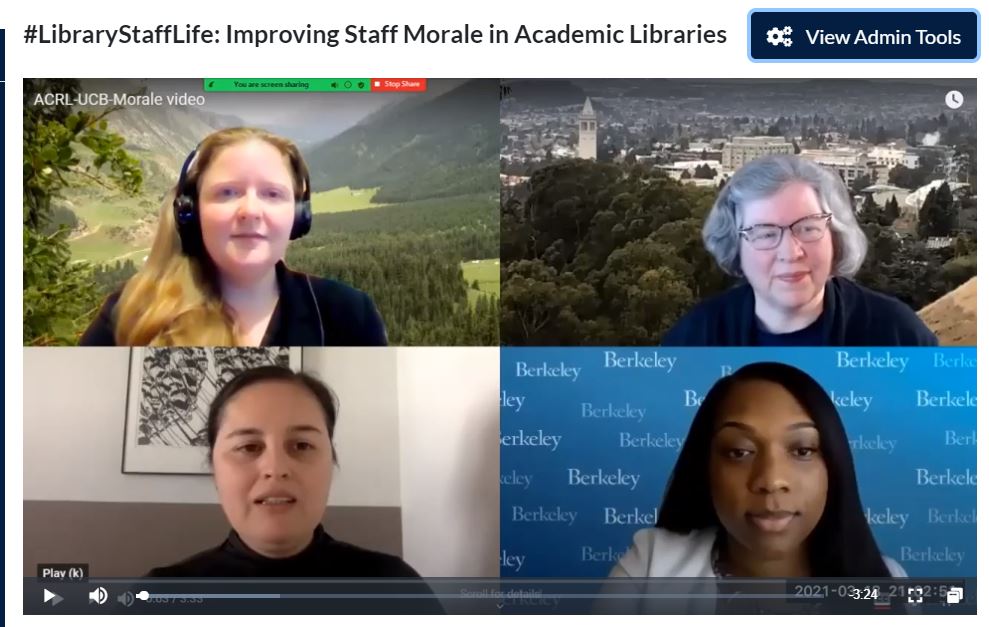
Even beyond those who believe that librarians sit around and read books all day (which would be delightful but is most definitely not our reality), many are surprised to learn that librarians double as active researchers. This is especially true in settings where librarians are members of the faculty, but even where that isn’t the case, such as at Berkeley, librarians are born investigators and it carries over into wanting to find out about and add to knowledge of our settings.
What does it look like to conduct library research? Glad you asked! In our case, it started with a conversation and an idea. Natalia Estrada (now Berkeley’s Political Science and Public Policy Librarian, then the Social Sciences Collection and Reference Assistant and in library school) and I were talking about how much we admired the work of Kaetrena Davis Kendrick. Kendrick wrote a foundational work in the study of librarian workplace morale, The Low Morale Experience of Academic Librarians: A Phenomenological Study, and it sparked many more studies on this topic. But, where were the studies of library staff experiences? We wanted to find out!
We were lucky to recruit two colleagues who added so much to the team: Bonita Dyess, Circulation/Reserves Supervisor at the Earth Sciences/Map Library, and Celia Emmelhainz, Berkeley’s Anthropology & Qualitative Research Librarian. First we applied for (and eventually got) funding for the research from LAUC (the Librarians Association of the University of California). This meant we could pay for transcribing our interviews, give the participants gift cards, and buy qualitative data analysis software. Then we applied for (and got) approval from the IRB (Institutional Review Board), making sure we were complying with processes for research with human subjects.
Here’s where the “pandemic edition” part comes in. All this planning and applying, starting in November 2019, took time; so, at the point we were actually ready to recruit participants, it was April 2020. We were sheltering in place, and not sure how this all would work (although it was probably better than having to go virtual in mid-stream)! Nevertheless, we hurled out information about and invitations to be part of the study to every list-serv, association, and friendly librarian we could think of, nationwide. We ended up doing 34 interviews with academic library staff from a range of locations and institution types (purposefully excluding the UC system), during a three-week period in May-June 2020. Due to COVID these were all online, either by phone or Google Meet (sort of like Zoom), and we asked a structured list of questions, with room for branching into other topics, or diving deeply. Celia trained a wonderful student to transcribe the interviews, and once we had those transcripts and stripped identifying information from them, we were off– coding away (using MAXQDA software), and drawing themes, quotes, recommendations, and other findings from the surprisingly rich information we’d collected.
Next—we had to start getting the information out into the world! Our eventual goal is to write a paper, or several, for publication. There are a number of library and information science journals out there that we are considering… but that takes time as well, and we wanted to start presenting our findings sooner. So, we did an “initial findings” presentation to the UC Berkeley Library Research Working Group, and then stepped into the big time with acceptance to present a poster at the 2021 Association of College and Research Libraries online conference (our poster got almost 600 views), and with a webinar we did for the Pennsylvania Library Association (both the poster and the webinar slides are available through the UC’s eScholarship portal). All our work to get to this point is hopefully now helping others.
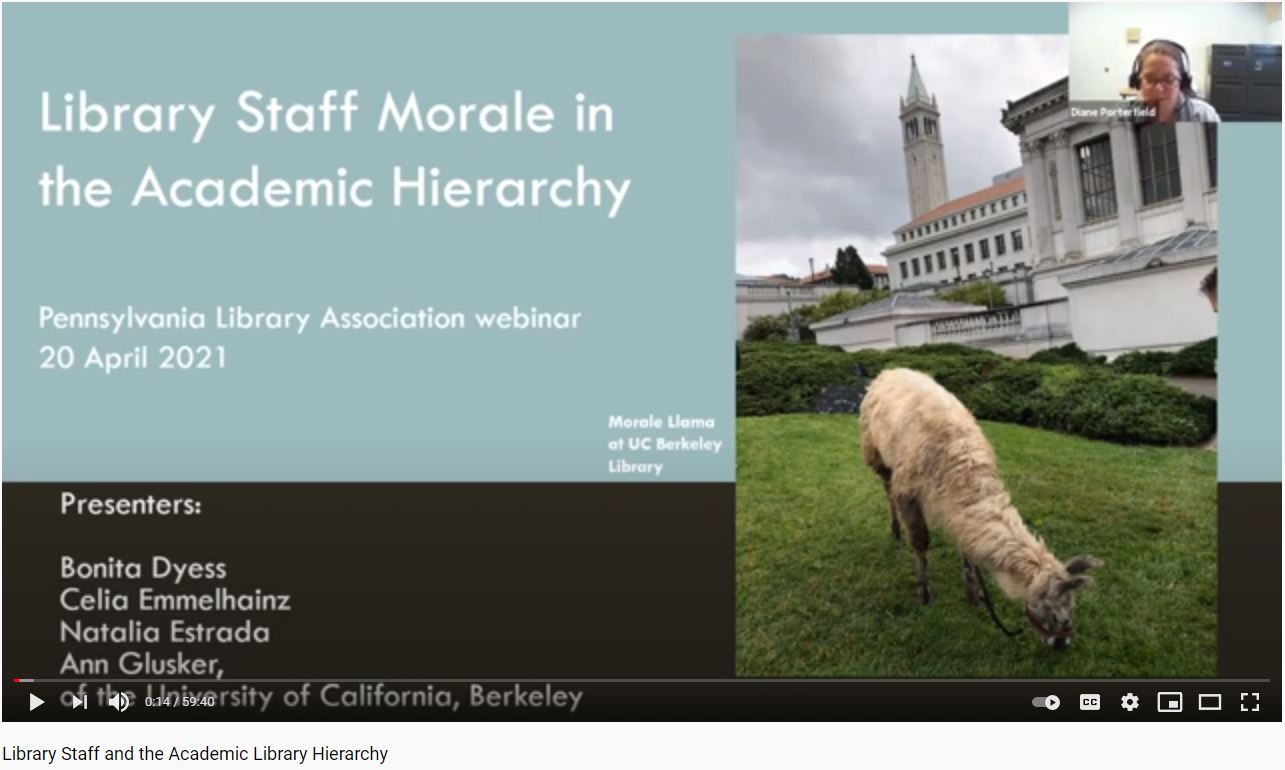
And, a word about connecting with our participants. We were bowled over by their generosity with us and by all they had to say: much that we didn’t expect, and much that they were grateful someone was even asking about. It ended up that we had captured one of the last opportunities to get a snapshot of pre-COVID library staff life; people were still in limbo, and talked about their regular jobs before any lockdowns, for the most part. At that point most expected to be back in their libraries and all to be normal by the end of the summer 2020. We know now that that didn’t happen, and we know that library re-openings and staff roles in them have been challenging and sometimes contentious; we wish we’d known to ask for permission to re-interview our participants—even if only to check in with them. But how could we have known? We wonder how they are.
So now, we have papers to write, and thinking to do about how to take our questions into new avenues of research—because it’s a never-ending, and completely exciting process, and, we suspect, will be very different (easier? or not?) in the post-COVID landscape. Do you have ideas for us? We’d love to hear them! Or want to hear more about our morale study? Please get in touch with us at librarystaffmorale@berkeley.edu!
Wikipedia, Knowledge Equity, and Researching Herstories

You may have heard that last week the Library hosted its now-annual Wikipedia edit-a-thon, a gathering of editors and fans of this amazing online resource (side note: speaking as a librarian who was taught that since Wikipedia is crowd-sourced it’s unreliable, I can say I’ve come to a much more appreciative stance after learning about its culture of fact-checking and reference, and in fact using the reference lists in articles on many occasions). Wikipedia is central to our knowledge landscape, and the UC Berkeley Library’s edit-a-thons are held so that we can improve on this landscape in the areas of art + feminism, and race + justice.
This year, because the edit-a-thon was virtual, we organizers were able to present a fascinating two-hour keynote and workshop given by Dr. Alexandria Lockett, of Spelman College in Atlanta. Dr. Lockett is a long-time Wikipedian (she started editing in 2003) who incorporates Wikipedia in her teaching, and works to question the politics of citation practices, representation, and knowledge equity there (check out her recent book chapter, “Why Do I Have Authority to Edit the Page? The Politics of User Agency and Participation on Wikipedia”).
Her talk, “Research for Knowledge Equity” had important content for everyone attending, whatever their Wikipedia editing level or interest. Dr. Lockett focused on knowledge production, and how that can “marginalize Black, Indigenous, People of Color (BIPOC) scholarship and media, LGBTQ persons, African scholarship and media, women scholars regardless of color, disabled scholars, etc.” (she noted that there are Wikipedia campaigns meeting this issue, particularly #CiteBlackWomen and “CiteaSista”). She then went on to outline methods and resources for doing herstorical research, particularly on the history of Black women. Bringing the perspectives of inclusive knowledge production and informed research strategies to our editing means that Wikipedia can start to become a force for change from within, moving towards knowledge equity. As Dr. Lockett notes, “This is intellectual labor, not just tacking on facts. It will change your perspectives on knowledge production.” Want to know more? Dr. Lockett has made her slides and her list of potential articles to edit available!
After the workshop, the edit-a-thon continued in its classic format, superimposed onto Zoom. We had an editing instruction session, a breakout room for one-on-one help, and one for open editing for those who wanted a collegial space in which to work. I, for one, felt fired up by what I’d heard from Dr. Lockett, and decided to see if I could improve an article on Carol Blanche Cotton (Bowie), a Black psychologist whose dissertation focused on cognitive testing of children with disabilities, and whose name was on a list of articles needing edits. Using my librarian super searching skills (AKA Google Scholar in this case), I found an online reference to her great grandmother, Rebecca Harris, in a 1983 article titled “The Antebellum ‘Talented Thousandth’: Black College Students at Oberlin Before the Civil War”. Once I did that, I was able to add the section circled in the image above to Dr. Cotton’s Wikipedia page. It felt so rewarding to connect Dr. Cotton to her ancestor, who believed so strongly in education that she moved her entire family to Oberlin, and along the way I learned more about two women—Dr. Cotton and Rebecca Harris—who I will never forget. I hope you, reader, will have the chance to get just as excited about learning and editing, in one of the many online editathons happening now, and also at our 2022 edit-a-thon—watch this space!